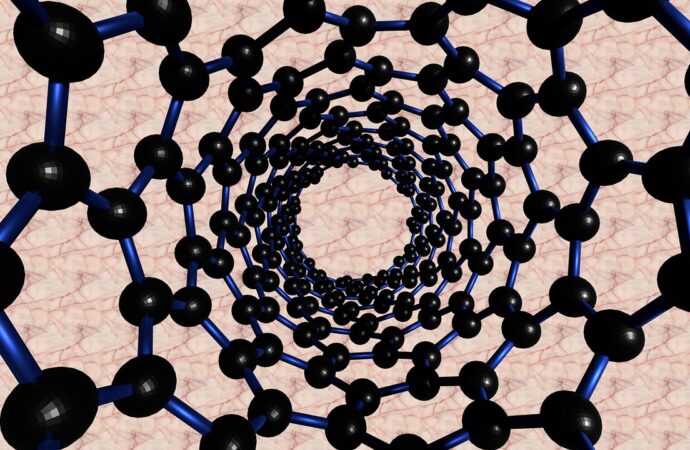Graphene is a single, one-atom-thick sheet of graphite, with carbon atoms arranged in a hexagonal pattern, as shown below:

Despite a rather humble appearance and an apparently simple structure, graphene has so far been shown to have some remarkable properties.
Super-light, yet super-strong
Imagine a cat laying on a hammock made from graphene. If the cat weighs four kg or less, one single sheet of graphene weighing less than a milligram and with an area of one m2 area would be enough to support the animal. The analogy is made by the Royal Swedish Academy of Sciences’ Class for Physics in a document that outlines graphene’s essential traits.
In 2008, Changgu Lee, professor at Sungkyunkwan University in South Korea, and his colleagues tested the material’s elastic properties. Their findings, published in the journal Science, show that monolayer graphene is, in fact, the strongest solid material ever measured.
One needs to apply a tension 100 to 400 times higher on graphene than on steel to break it. Graphene’s high breaking strength (42 N/m; for comparison, one-atom-thick-layer of steel has a breaking strength of 0.1-0.4 N/m) is mainly because of the interaction between the atoms of carbon. In graphene, each carbon atom binds to another three via covalent bonds, powerful chemical bonds that involve the sharing of electron pairs between atoms.
Despite this, graphite is still incredibly soft and weak. This is because the layers of graphene comprising graphite are held together by van der Waals bonds, which are the weakest form of chemical bonding.
Heat-related properties
Carbon has the highest-known ambient transition point of all the elements on the Periodic Table. To change it from solid directly to vapour, it is necessary to heat it at almost 4000 K (~3600ºC or ~6600 F) at room temperature and 1 atmosphere.
Graphene itself shares this property. Besides, this material is very effective at transporting heat. With a thermal conductivity of 5000 W/mK, graphite trumps copper (~400 W/mK) by one order of magnitude.
Main course – electrical “wizardry”
Here is where the primary interest in graphene lies; its electrical conductivity is roughly 50% higher than copper.
Graphene can also work as a semiconductor. The in-depth nature is explained by Cooper and colleagues in an article published in 2012, but the short of it is that graphene is a “zero-gap” semiconductor because no energy gap exists between the conducting and valence energy bands of the carbon atoms comprising graphene.
Furthermore, graphene, unlike most semiconductors that contain a single zero-momentum node, can possess two unique such nodes, each with a different corresponding energy. Meanwhile, most other semiconductors have some amount of “gap” present and usually only have a single associated node.

Above is an illustration of this for graphene: K and K’ are the two nodes in question. Each hexagon in the graphene lattice has three of each; Γ is a central node which for many other semiconductors is the only relevant node that exists.
Another unique trait graphene has as a semiconductor is its “massless electrons.” Because of the energy structure, shown above, electrons partaking in the semiconducting process in graphene appear like they have no rest mass and can travel at light-speed. Research still ongoing into this!
Since graphene is only one atom thick, it can produce a reasonably strong Casimir effect. The Casimir effect can occur between two sufficiently close planar materials (like two tabletops, for example), where the vacuum’s inherent electrical energies can cause the two materials to slowly come together, assuming no friction or other forces exist. Another ongoing research area!
Yet another area of ongoing research is in capacitors. Depending on design (the base that the graphene rests on, or lack thereof, can affect its electrical properties) and stimulation from electronic frequencies (graphene’s permittivity varies with input frequency, becoming more insulating as frequency increases), graphene can become either a conductor or an insulator. Theoretically, this material can be used to create ultra-compact capacitors that can store stupendous amounts of electrical energy.
Potential newly found properties of graphene?
Graphene already exhibits notable traits, surpassing most other known materials. Its primary interest lies in super-compact electronics and super-light materials, stronger than any synthetic polymer or known metal-alloy. What if it could also… give humanity free energy?
A recent study from researchers in the U.S.A and Spain delves into how to convert the Brownian motion of a graphene sheet into an—albeit minimal—amount of electrical power. In other words, this material could become a sort-of free-energy generator.
References:
– Lee, Changgu, et al. “Measurement of the elastic properties and intrinsic strength of monolayer graphene.” science 321.5887 (2008): 385-388.
– Cooper, Daniel R., et al. “Experimental review of graphene.” ISRN Condensed Matter Physics 2012 (2012).
– Thibado, P. M., et al. “Fluctuation-induced current from freestanding graphene.” Physical Review E 102.4 (2020): 042101.
Further reading:
– Cismaru, Alina, et al. “Microwave and millimeterwave electrical permittivity of graphene monolayer.” arXiv preprint arXiv:1309.0990 (2013).
– Du, Xu, et al. “Fractional quantum Hall effect and insulating phase of Dirac electrons in graphene.” Nature 462.7270 (2009): 192-195.
– Tombros, Nikolaos, et al. “Electronic spin transport and spin precession in single graphene layers at room temperature.” Nature 448.7153 (2007): 571-574.





